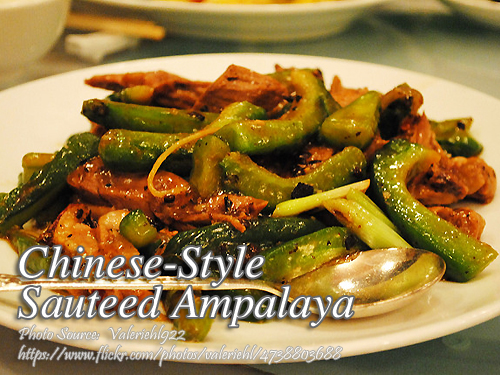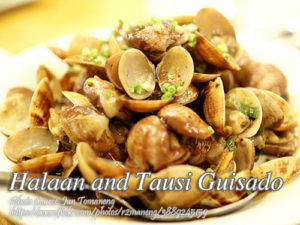Ginisang ampalaya or sauteed bitter melon is a popular Filipino vegetable dish. But the popular kind of ginisang ampalaya is with beaten eggs. This version has it’s Asian origin because of the fermented salted black beans or popularly known as tausi. It is common belief that to remove the bitter taste, you have to squeeze the sliced ampalaya with sea salt. But some are suggesting that you only have to soak it in brine to remove the bitter taste or soak it in water with a few teaspoons of baking soda. I suggest you try what really works. So if you are planning to cook an ampalaya recipe, I think this dish is a must try.
Chinese Style Sauteed Ampalaya
Ginisang ampalaya, or sautéed bitter melon, is a beloved Filipino vegetable dish known for its distinct taste and health benefits. Typically prepared with beaten eggs, this version brings an Asian twist to the table by incorporating fermented salted black beans, commonly known as tausi. This dish offers a delightful combination of flavors that even those who shy away from bitter melon might find appealing. The key to enjoying ampalaya lies in managing its bitterness, and there are various techniques to do so. This dish is a must-try for anyone looking to explore new culinary horizons.
A Brief History of Ampalaya
Bitter melon, scientifically known as Momordica charantia, is widely used in Asian cuisine. Originating in India, it spread across China and Southeast Asia, becoming a staple in many traditional dishes. In the Philippines, ampalaya is not only valued for its unique flavor but also for its medicinal properties. It’s rich in vitamins and minerals, particularly vitamin C, folate, and vitamin A. Throughout history, bitter melon has been used in various cultures for its health benefits, including improving digestion and boosting the immune system. The addition of tausi in this recipe highlights the Chinese influence on Filipino cuisine, showcasing the fusion of flavors and techniques that characterize many Filipino dishes.
Preparing the Ampalaya
To prepare the ampalaya, start by slicing and halving the bitter melon, removing the seeds, and cutting it into thick diagonal pieces. One of the most important steps in cooking ampalaya is reducing its bitterness. Traditionally, this is done by squeezing the slices with sea salt. However, soaking the slices in salted water for 10 to 15 minutes can also be effective. This method helps to mellow the bitterness without compromising the texture. After soaking, rinse the slices twice and drain them well. It’s crucial not to squeeze the ampalaya, as this can make it too mushy when cooked.
Sauteing to Perfection
Heat some oil in a pan and sauté the garlic until it turns brown, releasing its rich aroma. Next, add the onions and stir cook for about two minutes until they become translucent. The addition of onions not only adds sweetness but also balances the overall flavor of the dish. Introduce the pork and tausi to the pan, and sauté them together. The fermented black beans infuse the dish with a distinctive umami flavor, enhancing the taste of the pork and bitter melon.
Achieving the Right Texture
Add half a cup of water to the pan, cover it, and let the mixture boil until the pork is tender and most of the water has evaporated. This step ensures that the pork absorbs the flavors of the tausi and garlic, creating a rich base for the dish. Once the pork is cooked, add the liver strips and stir cook for about two minutes. Liver adds a creamy texture and depth of flavor, making the dish more robust.
Incorporating the Ampalaya
Now, it’s time to add the ampalaya to the pan, along with another half cup of water. Cover the pan and allow it to cook, stirring only once to ensure even cooking. It’s essential to cook the ampalaya just until it’s half done to retain its slight crunch and avoid overcooking, which can make it too soft and unappetizing. Finally, dissolve some cornstarch in water and add it to the pan. Stir gently until the sauce thickens, giving the dish a glossy finish. The cornstarch not only thickens the sauce but also helps to bind the flavors together.
Serving Suggestions
Serve the Cmmpalaya hot, ideally with steamed rice. The rice acts as a neutral base, absorbing the flavorful sauce and balancing the bitterness of the ampalaya. This dish can be enjoyed as a main course or as a side dish, complementing other Filipino or Asian dishes. Its combination of savory pork, creamy liver, and slightly bitter ampalaya makes for a complex and satisfying meal.
Food for Thought
Exploring traditional dishes not only broadens your culinary repertoire but also connects you with the rich cultural histories behind these recipes. Each ingredient and technique tells a story of migration, adaptation, and innovation. The use of tausi in this dish, for instance, reflects the Chinese influence on Filipino cuisine, demonstrating how culinary practices evolve and merge over time. As you savor this dish, consider the generations of cooks who have perfected these methods and the shared human experience of enjoying good food.
How to Cook Chinese Style Sauteed Ampalaya
Ingredients
- 1/2 kilo ampalaya or bitter melon
- 100 grams pork cut into cubes
- 100 grams pork liver cut into strips
- 3 Tbsp. tausi or salted blackbeans
- 1 large onion sliced
- 3 cloves garlic crushed
- 1 tsp. MSG or granulated seasonings
- 1 cup water
- 1 Tbsp. cornstarch dissolved in 1 Tbsp. water
- 2 Tbsp. cooking oil
Instructions
How to cook Chinese Style Sauteed Ampalaya:
- Slice and halve the bitter melon and remove the seeds. Then slice into thick diagonal pieces.
- Soak in water with a little salt for 10 to 15 minutes. Wash 2 times and drain to lessen the bitter taste. Do not squeeze. Set aside.
- Heat oil in a pan and saute garlic until brown. Add onion and stir cook for 2 minutes. Then add pork and tausi.
- Saute for a while and add 1/2 cup water. Cover and let boil till pork is tender and water has almost evaporated. Then add liver strips.
- Stir cook for 2 minutes then add the ampalaya, pour in another 1/2 cup water. Cover and stir only once.
- When ampalaya is half done, add dissolved cornstarch. Stir gently until the sauce thickens. Be careful not to overcook the ampalaya. Serve hot.
Notes
Cooking Tips
Balancing Bitterness To reduce the bitterness of ampalaya, soak the slices in salted water for 10 to 15 minutes instead of squeezing them. This method preserves the vegetable's crisp texture while mellowing its strong flavor. Rinse thoroughly after soaking to remove excess salt. Cooking the Pork and Liver Ensure the pork is tender and well-flavored by allowing it to simmer with the tausi and garlic until most of the water evaporates. This process infuses the meat with rich, savory flavors, making it the perfect complement to the ampalaya. Adding the liver strips at the right moment ensures they cook evenly without becoming tough. Perfecting the Sauce Dissolve cornstarch in water before adding it to the dish to avoid lumps and achieve a smooth, glossy sauce. Stir gently to incorporate the cornstarch mixture evenly and thicken the sauce without breaking the ampalaya slices. This step binds all the flavors together, enhancing the overall taste and texture of the dish.






Informative and easy to make the recipe. Thanks for sharing with us.
Thanks Loui for the kind words. Cheers!
very helpful. great recipes and simple